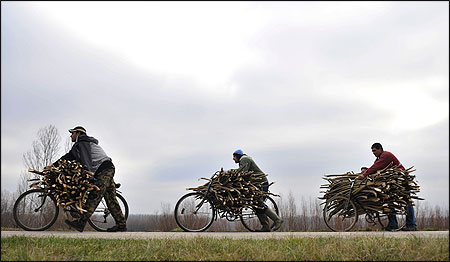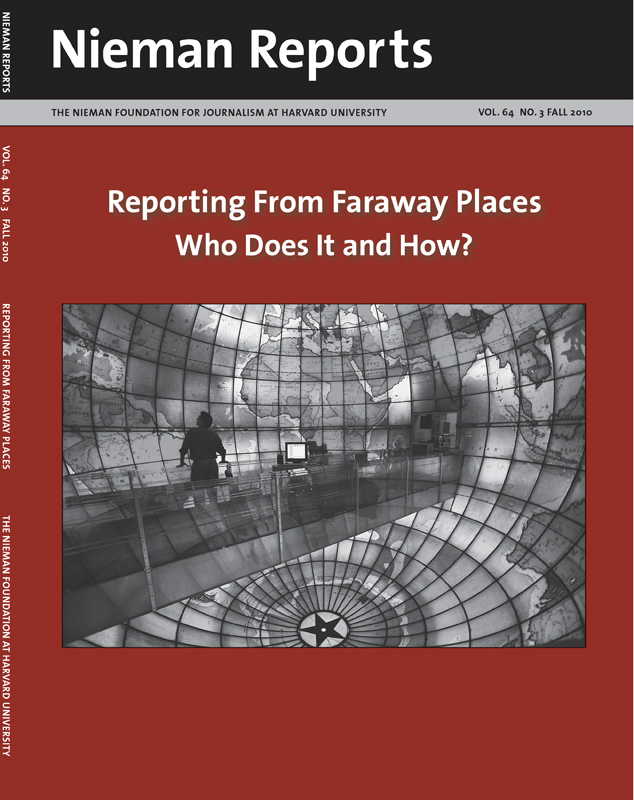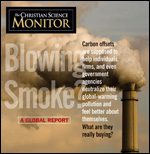
In Hungary, villagers push bicycles with firewood past where the “Vatican Forest” was supposed to be planted by KlimaFa, which marketed carbon offsets as a way to neutralize CO2 emissions and lessen global warming. Photo by Bela Szandelszky.
Foreign news reporting can be married to a new model of journalism. Just be prepared: Planning for this wedding takes an awful lot of time and it is likely to make one nostalgic for a newsroom.
These are among the lessons I learned while working on a project that stretched across 16 months, five continents, and four institutions and involved more than 22 people and 841 e-mails (mine alone) to produce an investigative series examining the abuses and inefficiencies of the carbon offset marketplace. These stories debuted in an eight-page spread in The Christian Science Monitor’s glossy weekly newsmagazine and in multimedia editions on the Web sites of the Monitor and the New England Center for Investigative Reporting (NECIR). Its publication spawned radio reports, elicited wounded howls from two of its exposed targets, and drew recognition with an award for public service.
Amid all of the chattering about new models of journalism, there is relatively little talk about foreign reporting. That is because foreign reporting is the most costly, logistically challenging, and time-consuming branch of journalism. Throw an investigative topic into the mix, and it’s a formula for a long and expensive endeavor. Yet with a willingness to ignore traditional boundaries, NECIR and The Christian Science Monitor teamed up to produce just such a report.
An Idea + Money
Here is how it came together: In January 2009 I was chatting with Joe Bergantino, a veteran investigative reporter who left Boston’s premier television investigative team to launch a nonprofit investigative center with Maggie Mulvihill, another dogged print and broadcast reporter. When I mentioned my suspicions about the potential for scams in the global See Mulvihill and Bergantino’s story about the university-based New England Center for Investigative Reporting in the Summer 2009 issue of Nieman Reports »marketplace of carbon offsets—offering certificates that promise to offset a buyer’s carbon footprint—he seized on it.
But first, he said, go out and raise the money for it.
This was my first rude awakening. For a reporter who had spent all of his 30-plus years in the business on the bankroll of newsrooms, mostly The Washington Post and The (Baltimore) Sun, the idea of having to raise money before I could even start to report was a wholly new concept.
But Joe encouraged me to tackle the unfamiliar realm of nonprofit foundations. I made calls and wrote pitch letters. Six months later, I’d come up with … nothing. It wasn’t fun; I wasn’t reporting, and I wasn’t paying the rent. When Emerson College offered me a faculty position teaching journalism, I thanked Joe for the interesting experience and said goodbye.
Or so I thought.
A few months later, he called: “One of the grant proposals went through. We’re getting the money.”
“I’ve got another job. I don’t have time now,” I protested.
“Can’t back out now,” he replied.
Assembling a Reporting Team
This grant from the St. Louis-based Deer Creek Foundation gave us a healthy start. It would pay for the U.S. reporting. Joe and Maggie could marshal help from students at Boston University (BU), where NECIR is based. I enlisted a bright, savvy journalism graduate student at Emerson College, Katy Jordan, for the project. I also had invaluable technical help from students and staff at Emerson for the video component.
For the story to work, however, we would need on-the-ground reporting from many international locations. We could squeeze one overseas trip from the budget so I picked the best target for our reporting and headed to Hungary. But we clearly would not have the funds, time or reporters to visit the other locales.
A few blocks away in Boston are the offices of The Christian Science Monitor. This news organization is one of a dwindling few with the valuable asset we needed: a veteran and respected foreign staff. Joe and I knocked on the door of The Monitor’s editor, John Yemma, and presented him with a proposal that only a few years ago would have been considered audacious: Can we enlist your foreign staff to partner with our nonprofit organization, two college journalism programs, and reporters who don’t work for you, for a story to run in your weekly magazine and on your Web site?
Yemma was comfortable with experimentation. He had taken the Monitor from a daily print newspaper to a weekly print newsmagazine and daily online news operation in March 2009 and no longer sees old boundaries as sacrosanct. He did not flinch.
Our reporting partnership began last December with the Monitor’s “far-flungs,” as foreign correspondents used to be called. International Editor David Clark Scott and the magazine’s Senior Editor Clara Germani embraced the arrangement with impressive collegiality. They gave me direct access to the foreign reporters. We consulted one another at each step as reporters were dispatched to obscure spots to report this story. They also sent photographers Melanie Stetson Freeman and Mary Knox Merrill and, with only some misgivings, equipped them with video cameras. They also tapped their freelance network to fill holes in the coverage.
The stories were constructed out of my reporting and the files received from five other reporters—Sara Miller Llana in Panama, Ilene R. Prusher in Israel, Ben Arnoldy in India, freelancer Kathy Marks in Australia, Jordan in New England, with additional reporting by Peter Ford in China. In a Herculean sprint of late-night stints, Germani transformed all of this into a smoothly edited package with a main story, five sidebars, graphics, photographs and the video. It ran in the Earth Week issue of the magazine and was posted online on April 20.
Assessing Our Effort
A success? Yes. We produced an investigative piece that neither the Monitor nor the NECIR would have undertaken on its own. The Deer Creek Foundation’s money helped to make it possible and the assistance we received from the journalism schools at Emerson and BU was vital.
Yet, I realized, too, what a great invention the old newsroom was and how efficient newsrooms could be, despite their chaotic personas. At the Post, I could have done this project—from idea to publication—in two or three months, instead of 16. Once sold on the story, editors would have allocated the funds, summoned help from other correspondents, dispatched photographers, graphic artists, and sewed the thing up with a legion of editors. Virtually unseen, other gears would have clicked in: lawyers to check it, production people to create and distribute it, and marketers to promote it.
In this case, staff in the Monitor’s newsroom provided a healthy chunk of this kind of support. But the coordination among so many players was strenuous. For example, to protect each responsible entity, we had to run the story through three legal reviews—at the Monitor, at BU, and at the Boston-based NPR radio station that ran part of our report. For the video piece, the diversity of formats used by the Monitor’s photographers, local crews working with NECIR, and a crew I assembled in Hungary proved a technological nightmare. And Joe was in perpetual motion just trying to arrange outlets and cooperative play for the package.
And of course our work was juggled around students’ schedules, teaching calendars, and Joe’s other directing duties at NECIR. Hanging over this project always was the question of whether our budget would be enough. It wasn’t, thus serving, I suppose, as a valuable lesson for future fund-raising.
This is clearly not a nimble or a fast process. Without trust and cooperation, our effort could have been stopped cold at a number of institutional boundaries. And readership returns for such an effort remain a question, given the ever-present challenge of drawing eyes to stories in a fragmented media environment.
Is all of this worth the result? Ever the optimist, Joe declared the story a success as he plunged into the next one. Perhaps nonprofits like NECIR will one day be flush enough to have their own cadre of far-flungs or have a budget big enough to send reporters abroad. Until then, they will have to depend on novel arrangements and cooperative goodwill with news operations that do.
Doug Struck, a 2004 Nieman Fellow, is associate chairman of the journalism department at Emerson College in Boston. For 12 years he was a member of the foreign staffs of The Washington Post and The (Baltimore) Sun and reported from six continents.




